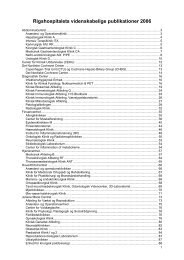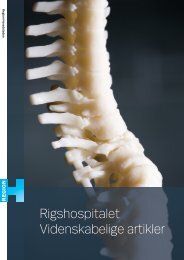View - CTU
View - CTU
View - CTU
You also want an ePaper? Increase the reach of your titles
YUMPU automatically turns print PDFs into web optimized ePapers that Google loves.
English summary<br />
There is a great discrepancy between the healing rates that can be achieved with<br />
endodontic treatment and those found in most populations as performed by General<br />
Dental Practitioners (GDPs). This 'gap' was the starting point of the present<br />
dissertation. Factors that influence the endodontic treatment quality in general dental<br />
practice are not very well known. Quality is shaped in an interplay between the<br />
knowledge, attitudes, and skills of the dentist as well as the demand and satisfaction<br />
of the patient framed in a context that eventually involves the whole of society. The<br />
overall aim was to reveal reasons, prevention, and quality-shaping factors that<br />
influence endodontic treatments in general dental practice.<br />
The first part of this dissertation examines the incidence and reasons to perform<br />
endodontic treatments in Denmark. Based on a 25-year record of annual treatment<br />
statistics obtained from the Danish Dental Association and the Danish National<br />
Health Insurance the endodontic-related service pattern among GDPs showed an<br />
increased frequency (17%) of performed root fillings per 1000 patients (Study I) and<br />
an increased rate of root fillings per tooth. Using a questionnaire among 600<br />
randomly selected Danish GDPs, the most common reason for performing root canal<br />
treatments was caries in vital teeth (55%)(Study II).<br />
The next part of the dissertation shows the potential of an endodontic preventive<br />
treatment strategy in deep caries in adults. Deep caries excavation was investigated<br />
in a randomized clinical multicentre trial (Study Ill, excavation trial) comparing<br />
stepwise excavation and direct complete excavation. In a nested randomized trial<br />
pulp capping procedures (direct pulp capping versus partial pulpotomy) were<br />
compared (Study Ill, pulp capping trial) in patients where excavation had led to pulp<br />
exposures. Stepwise excavation was significantly better in preventing pulp exposure<br />
and the proportion of patients with sustained tooth vitality without apical radiolucency<br />
at -1 Yz-year follow-up was significantly higher in the stepwise excavation group<br />
(74.1%) versus the direct complete excavation group (62.4%). In patients where pulp<br />
capping procedures were carried out, direct pulp capping (31.8%) and partial<br />
49








